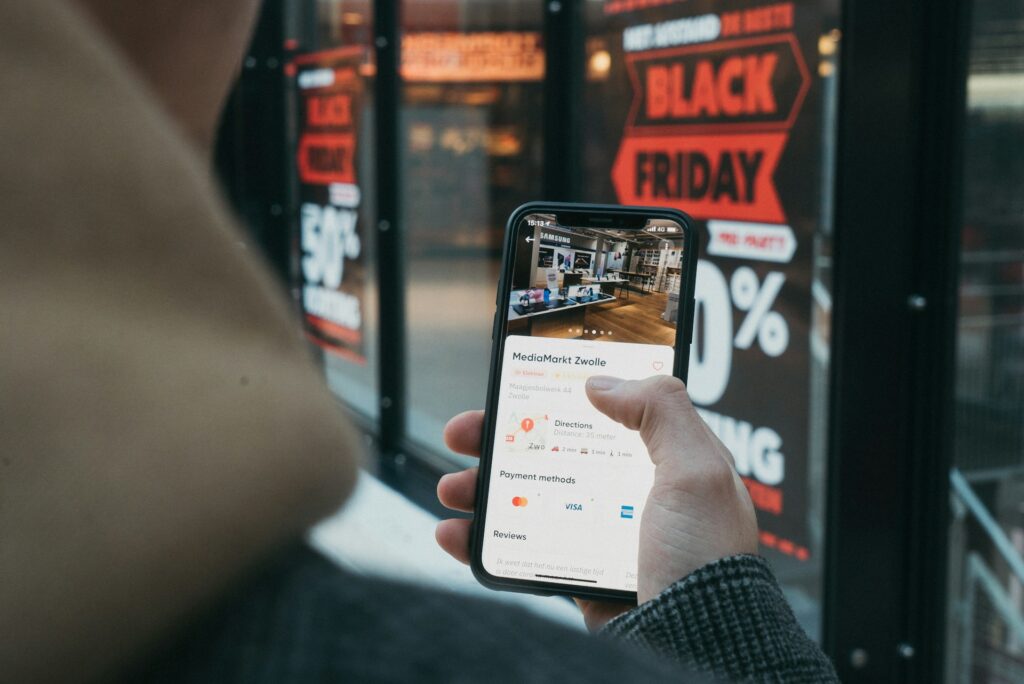In the United States alone, the number of online shoppers reached 244 million in 2022 and is expected to rise to nearly 288 million by 2025. E-commerce is ever-evolving, so staying ahead of emerging trends and optimizing advertising strategies are crucial if you want your online shopping app to become successful.
The global online retail market consists of over 26 million businesses, and new ones are being established constantly. If you find these figures daunting, it’s important to note that fewer than 1 million of these websites generate sales of over $1,000 per year, indicating there are ample opportunities for new ones to come and grow. By the end of 2024, numerous impactful trends and seasonal shopping spikes will likely have shaped the online shopping experience and brought many significant changes.
Understanding trends like AI-powered personalization and augmented reality shopping, as well as an increase in sustainable practices and voice commerce, is crucial for marketers or app developers who are looking to thrive in competitive markets.
Recognizing regional shopping patterns such as Diwali in India, Ramadan in Indonesia or Black Friday in the USA can give businesses an added edge in identifying key trends and taking actionable steps to capitalize on them. In this article, we explore these key trends to give our readers insights on how best to leverage them for mobile OEM advertising efforts and grab the attention of target audiences. Let’s get into details to discover how we can harness them effectively for mobile OEM advertising efforts that reach out to target audiences!

Photo by Gilles Lambert on Unsplash
What is mobile shopping?
Mobile shopping is revolutionizing how people engage with products and services, positioning smartphones at the core of online shopping or retail experiences. 8 out of 10 people carry their phones everywhere they go, and 96% use them for product research purposes alone. M-commerce (mobile commerce) represents not merely an emerging trend but an essential shift in consumer behaviors.
Convenience has played a vital role in driving online shopping’s growth, giving shoppers access to products in any location with just a few taps on their screens.
M-commerce
M-commerce is constantly developing, with mobile websites, dedicated apps, and native applications increasingly becoming sophisticated. Mobile shopping apps, in particular, can offer personalized experiences tailored to individual preferences via sophisticated algorithms that analyze user behavior. When you combine this element with fast payment systems such as Apple Pay or Google Wallet, this level of personalization makes mobile shopping an appealing option for busy customers.
Q-commerce
Q-commerce (quick commerce), one of the latest advances in this space, takes convenience one step further, with delivery times as fast as under an hour. It is now extremely popular among urbanites who need access to groceries, meals, and essentials instantly, utilizing advanced logistics systems and local distribution centers for this seamless shopping experience.
Risks and Solutions
However, mobile shopping does come with some risks. For example, security remains a primary concern as consumers worry about data breaches and fraud. Also, user experiences vary widely depending on design/functionality considerations when creating mobile applications or platforms. Connectivity problems in areas with limited internet service can impede shopping experiences as well.
Payment options, though varied, can sometimes complicate the checkout process when one isn’t compatible with another payment option. But mobile shopping remains optimistic for its bright future!
Emerging technologies such as 5G promise faster and more dependable internet connections. Blockchain could also enable more secure transactions. Artificial intelligence (AI) and Machine Learning (ML) will facilitate greater customization for shoppers by giving them more tailored shopping experiences. At the same time, machine learning could make its mark with highly personalized shopping experiences.
Virtual shopping assistants and the seamless integration of IoT devices promise to make mobile shopping even easier and more accessible.
Learn more about “Everything You Should Know About Mobile Shopping.”

Photo by Kenny Eliason on Unsplash
Personalizing shopping experience for customers
Personalizing customer experiences is vital to driving customer loyalty and increasing revenue for brands. 76% of shoppers prefer purchasing from brands offering tailored experiences.
Therefore, brands should prioritize personalization when designing online shopping apps. Making it simpler for shoppers will permit them to navigate and locate what they are searching for quickly and effortlessly. Customized experiences increase engagement levels, conversion rates, customer retention rates, and, ultimately, brand loyalty.
Data collection
Collecting relevant customer data is crucial to creating effective personalization. Customer profiles, browsing histories, purchase histories, and feedback all offer valuable insights that can be leveraged to customize customers’ shopping experiences. However, for maximum effectiveness, they need to remain transparent about the use of this information. Opt-in features should also be enabled to protect user privacy.
Personalizing techniques with product recommendations, collaborative filtering, and content-based filtering can significantly enhance user experiences. AI/ML can analyze user behavior to predict preferences and further tailor recommendations. Additionally, improving search functionality within apps and planning to include user-generated content such as reviews can build trust among customers, allowing repeat purchases to increase over time.
Leveraging technology such as AI-driven analytics, CRM systems, and A/B testing enables brands to fine-tune their personalization strategies. Creating a seamless omnichannel experience ensures consistent branding and unified customer profiles across platforms, allowing smooth transitions between different shopping channels.
Social media plays an invaluable role in personalization by offering targeted ads, showing social proof, and including augmented reality (AR) to enhance product visualization.
Measure the results
Measuring the success of personalization using KPIs and customer feedback enables continuous improvements that ensure shoppers’ experiences remain engaging and relevant for shoppers.
Personalization done right not only meets but surpasses customer expectations; it creates long-term loyalty while driving app growth.
Ready to take your online shopping app to the next level? AVOW offers unparalleled mobile OEM advertising solutions, ensuring your app gets noticed on the most popular devices and alternative app stores from Samsung, Xiaomi, Huawei, OPPO, Vivo, and more. With our global reach and strategic partnerships, we can help you reach new audiences, boost user acquisition, and drive significant growth. Reach out today to start personalizing your customer experience with OEM advertising!
Learn more about “How to personalize the shopping experience for your customers.”

Photo by CardMapr.nl on Unsplash
Best practices when developing a shopping app
Target audience
A crucial part of building an effective shopping app lies in having a firm grasp of your target audience. Conduct comprehensive market research in order to learn user demographics, preferences, and behaviors as you make inferences from this data that help shape features and design to address user needs and build upon this solid base for the future success of your shopping app.
Prioritize user experience (UX)
A great UX design ensures your app is intuitive and easy for users to navigate. Users should find what they are searching for quickly without becoming frustrated. Key aspects include simplifying navigation and fast load times. Consistent design across devices also contributes to an enjoyable shopping experience.
Optimize checkout and payment process
Another critical aspect is optimizing the checkout and payment processes. Studies reveal that an overly complex or lengthy checkout can cause significant cart abandonment. When brands use features like guest checkout and multiple payment options to expedite this step, they can significantly reduce cart abandonment. Introducing new features such as guest checkout or “Buy It Now” buttons along with traditional “Add to Cart” buttons will further streamline purchasing experiences by appealing to both impulse buyers and those preferring browsing before buying.
Security
Security should always come first. With increasing concerns over cyber threats, protecting user data must take precedence. Implement SSL encryption when processing transactions and secure payment gateways. Regular updates to your app’s security features are essential to stay ahead of potential vulnerabilities and maintain user trust.
These strategies will assist in designing an exceptional shopping app with outstanding user experiences, creating customer loyalty in its users and increasing retention rates.
Learn more about the “7 Best Practices When Building a Shopping App.”

Photo by Paul Hanaoka on Unsplash
Customer retention
Customer retention can bring numerous benefits to online shopping businesses, including cost efficiency, increased profits, and brand advocacy. Retaining existing customers often proves more cost-effective than acquiring new ones, potentially saving businesses substantial sums annually.
Personalize experiences
To effectively retain customers, begin by customizing their experience using data analytics, tailoring offers and recommendations based on individual preferences by sending product suggestions or birthday discounts, and providing 24/7 customer service through live chat. These strategies can increase loyalty while raising customer satisfaction levels significantly.
Make your loyalty program work
Establishing an engaging loyalty program can drive repeat business. Offer point systems, exclusive discounts, or early access to sales to entice repeat visits from existing and potential customers alike. Engaging with your customers across multiple channels such as social media, email, and mobile apps is excellent for keeping the brand at the top of customers’ minds. Also, solicit and act upon customer feedback to optimize user experiences while showing that customer input matters!
Use technology
Technology plays an integral part in customer retention. As said earlier in this article, analytics can be used to gain an in-depth understanding of shopping patterns, artificial intelligence can be used for instant support and personalized recommendations, and automation can be used to manage loyalty programs and communications efficiently.
Always measure
Measuring your retention efforts is crucial. Key metrics include Customer Retention Rate (CRR), Repeat Purchase Rate (RPR), Customer Lifetime Value (CLV), and Net Promoter Score (NPS). These indicators can help you to gauge the success of your retention strategies and identify areas for improvement.
Learn more about “Everything You Need to Know About Customer Retention in Online Shopping.“
Best Shopping Seasons
Mobile OEM advertisers need to capitalize on peak shopping periods worldwide such as Diwali in India, Ramadan in Indonesia, Black Friday/Cyber Monday in America, and Singles Day in China—for maximum marketing impact.
Keep track of key dates
Understanding regional shopping spikes is crucial. Diwali features deep discounts on clothing and electronics, while Black Friday boasts massive sales across numerous categories in the U.S. To prepare for these events in time, make a plan early. Brands need to develop assets early and secure prime slots on mobile devices ahead of time. These steps ensure optimal success at events like these!
Effective mobile OEM advertising demands precision targeting. Tailor your ads for local audiences that reflect cultural nuances and shopping preferences. For example, highlight festive item promotions during Diwali while emphasizing electronics deals during Black Friday sales events.
Customize ads
Take advantage of data-driven personalization to enhance ad relevance. Leverage user insights to tailor ads that capture attention and drive conversions, using preinstalled apps or native ads along with push notifications as a means for optimal ad formats to ensure seamless user experiences.
Real-time analytics are an essential part of campaign optimization. They enable advertisers to monitor performance closely and make adjustments based on metrics like click-through rates and engagement levels. A/B testing creatives help determine which ones resonate most with audiences, ensuring that your ad campaigns are as efficient as possible.
Plan Early
By planning early, targeting effectively, and personalizing ads with real-time data, you can maximize the effectiveness of your campaigns during these busy shopping seasons.
Maximize your brand’s visibility during peak shopping seasons with strategic mobile OEM advertising. Plan early, target precisely, and personalize your ads for local audiences. Partner with us to secure prime ad placements on mobile devices and drive conversions during key global events like Diwali, Black Friday, and Singles Day. Reach out today to elevate your mobile advertising strategy and stay ahead of the competition!
Learn more about “From Black Friday to Diwali: Mobile OEM Advertising Tips for Every Market.”

Photo by Blake Wisz on Unsplash
Shopping trends 2024
As 2024 approaches, several significant trends will shape the online shopping landscape:
AI-driven personalization
Artificial Intelligence (AI) is revolutionizing online shopping by creating highly tailored experiences for customers. AI algorithms leverage customer information such as browsing habits and purchase history to deliver tailored product recommendations and marketing messages, increasing user engagement while simultaneously improving conversion rates and retention rates for retailers who invest in AI technology – meeting individual customers preferences while keeping ahead of competitors with personalized experiences for each shopper while keeping costs under control.
Augmented reality (AR)
AR technology is becoming an increasingly mainstream shopping option, providing consumers with virtual interactions between products in virtual space before deciding to purchase. AR allows customers to see how furniture would look in their home or how shoes will fit, making for more informed and seamless purchasing experiences between online and physical shopping experiences. Thus, it can potentially decrease return rates by helping customers make informed purchases more quickly.
Sustainability
Environmental consciousness has made sustainability an essential consideration when making purchasing decisions, with consumers increasing their preference for eco-friendly brands and products. Brands that prioritize sustainable practices such as ethical sourcing, minimal packaging, and carbon-neutral shipping are likely to attract these shoppers while simultaneously meeting consumer demand for greener solutions. Adopting sustainability practices not only builds brand equity but also aligns with growing interest in greener alternatives.
Social commerce
Shopping directly via social media platforms like Instagram, TikTok, and Facebook is gaining momentum. Social commerce features, including shoppable posts and live-stream shopping events, allow users to browse and buy products seamlessly within their favorite apps. This trend is prevalent among younger consumers who use social media for product discovery and purchases. Retailers should focus on creating engaging content and leveraging influencer partnerships to maximize their reach and impact on these platforms.
Voice Commerce:
With voice-activated assistants like Amazon Alexa and Google Assistant becoming more prevalent in consumer lives, voice commerce has become more pervasive than ever. Shoppers are using these assistants to search for products, purchase them, and track orders with voice searches, a convenient, hands-free alternative for busy shoppers. Ecommerce platforms should ensure product information can easily be reached using these voice assistants so retailers don’t lose out to this growing segment of shoppers.
These trends demonstrate why app developers or marketers should leverage technological developments and adapt to consumer preferences as part of a holistic online shopping environment strategy to be successful.
Learn more about “7 Online Shopping Trends to Look Out for in 2024.”
Conclusion
Navigating the shifting waters of online shopping requires an intricate knowledge of both evolving trends and advertising practices. Looking ahead into 2024, AI-powered personalization, AR features, and other key trends will play an essential role in providing engaging shopping experiences to consumers.
Combine awareness of local shopping peaks and a sustainability commitment to stay ahead in a highly competitive landscape. Implementing such strategies increases customer engagement, conversion rates, and loyalty, which in turn leads to business success.
Stay informed and agile to adapt to these changes, and leverage the latest technologies to optimize your mobile OEM advertising.
Ready to elevate your strategy? Contact us today to learn how AVOW can help you stay at the forefront of mobile marketing innovation and maximize your success in the evolving e-commerce landscape.
About the Author






